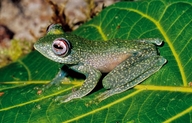|
Description
M 35-36 mm. Dorsum typically dark green with numerous small white spots. Iris colour with a red ring in the outer iris area, similar to B. luteus (Glaw and Vences 2007).
Distribution and Habitat
Country distribution from AmphibiaWeb's database: Madagascar
Anjanaharibe, Marojejy (Glaw and Vences 2007). It occurs at 800-1,000 m asl, in both pristine rainforest and slightly degraded habitat adjacent to pristine forest (Andreone and Nussbaum 2008).
Life History, Abundance, Activity, and Special Behaviors
Males call at night from trees, 2-4 m above the ground, along streams in rainforest. Calls consist of a relatively long-lasting, extremely fast series of short unharmonious notes, not easily recognized as a frog call (Glaw and Vences 2007). This species breeds in streams (Andreone and Nussbaum 2008).
Trends and Threats
Found in at least one protected area, the Réserve Spéciale d’Anjanaharibe-Sud. This species is common within its range, though the range is not large. It can tolerate a small amount of habitat degradation. Threats include habitat loss due to increasing subsistence agriculture, logging, charcoal manufacture, invasion and spread of eucalyptus, increased grazing, and expanding human settlement (Andreone and Nussbaum 2008). Possible reasons for amphibian decline General habitat alteration and loss
Habitat modification from deforestation, or logging related activities
Intensified agriculture or grazing
Subtle changes to necessary specialized habitat
Comments
Taken partly from Glaw and Vences (2007), with permission.
References
Andreone, F., and Nussbaum, R. (2008). Boophis anjanaharibeensis. In: IUCN 2008. 2008 IUCN Red List of Threatened Species. www.iucnredlist.org. Downloaded on 23 March 2009.
Glaw, F., and Vences, M. (2007). Field Guide to the Amphibians and Reptiles of Madagascar. Third Edition. Vences and Glaw Verlag, Köln.
Originally submitted by: Miguel Vences and Frank Glaw (first posted 2009-03-17)
Edited by: Kellie Whittaker (2010-07-19)Species Account Citation: AmphibiaWeb 2010 Boophis anjanaharibeensis <https://amphibiaweb.org/species/5778> University of California, Berkeley, CA, USA. Accessed May 16, 2025.
Feedback or comments about this page.
Citation: AmphibiaWeb. 2025. <https://amphibiaweb.org> University of California, Berkeley, CA, USA. Accessed 16 May 2025.
AmphibiaWeb's policy on data use.
|
